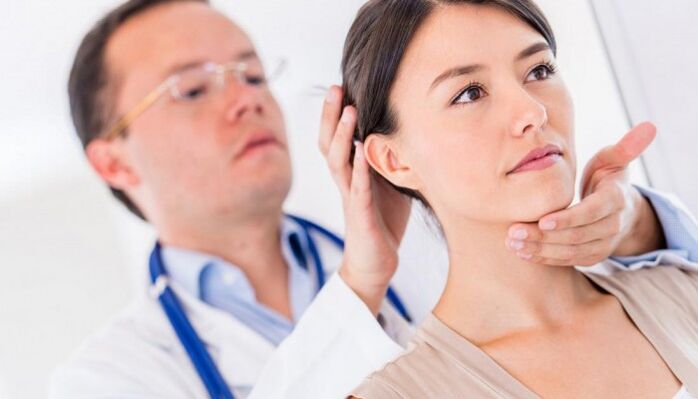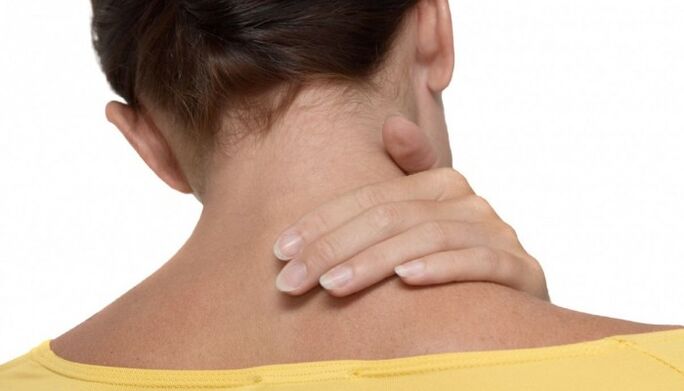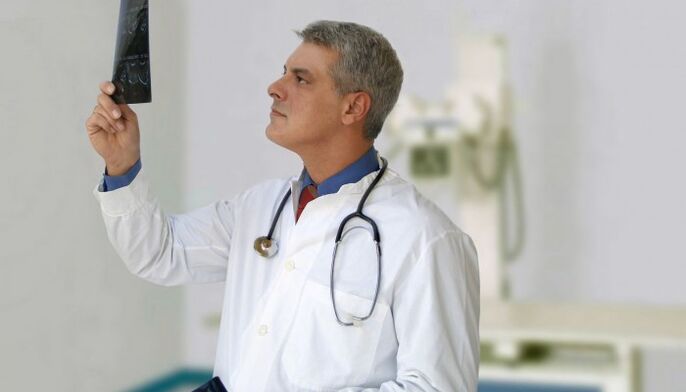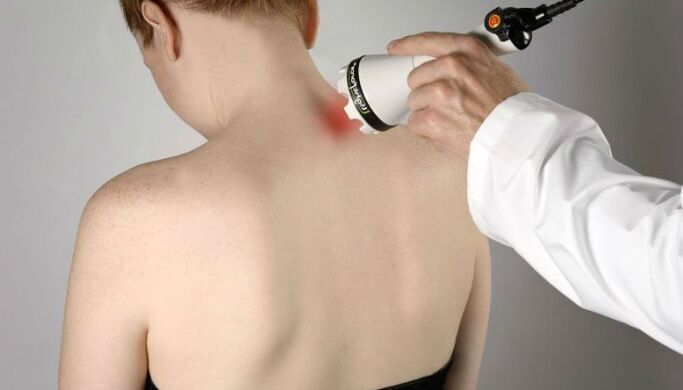Various back or side neck pains can occur suddenly and always cause discomfort. Particular caution should be due to the constant painful sensations. Neck pain and pain in the upper back can also be accompanied by other clinical signs, such as heaviness in the back of the head, fatigue, tiredness, headache, limitation of movement.
If the pain syndrome persists for more than a week and the treatment performed does not bring the desired results, professional medical help should be sought. Don’t deprive yourself of the opportunity to get rid of a painful illness quickly and effectively.
The reasons

Quite a few are wondering why his neck hurts? As practical experience has shown, there are many reasons for this. Clarification of such issues should be addressed exclusively by specialists, as the validity of treatment directly depends on this. The most common reasons why the back and back of the neck can hurt badly and often:
- Pathology of the cervical spine (various injuries, bruises, displacements, intervertebral hernias, osteochondrosis, spondyloarthrosis, etc. ).
- Myogelosis of the neck.
- Great physical activity.
- Staying for a long time in an uncomfortable state (e. g. , sleeping in a sitting position).
- Cervical sciatica.
- Muscle stretching (sudden head movements, improper exercise).
It has been shown that even superficial scoliosis can cause pain.
Pathology of the cervical spine
If the patient complains that his neck and upper back ache quite strongly and frequently, it is first necessary to exclude pathology of the cervical spine.
Special attention should be paid to osteochondrosis and spondylosis. Today, these are the two most common spinal diseases, apart from injuries and injuries that can cause very significant pain and discomfort in the neck and upper shoulder girdle. Characteristics of pain syndrome in degenerative-dystrophic pathology of the cervical spine:
- Pain was noted at rest, although the patient tried not to move at all.
- It is usually difficult for them to choose a position where they will not feel a painful sensation.
- Limitation of movement in the cervical spine is almost always observed.
- Slight pressure on the cervical vertebrae can cause increased pain.
Myogelosis of the cervical spine

A pathological condition in which there is painful compaction of muscle fibers associated with a violation of local blood circulation is called myogelosis. As a rule, the provoking factors are:
- Hypothermia and freezing.
- The draft blew.
- Prolonged uncomfortable position.
- Physical fatigue (excessive stress).
A large number of experts believe that myogelosis should be considered a complication after the inflammatory process in the muscles. It should be noted that it is manifested not only by pain, but also problems with muscle relaxation, increased tone, and limited movement arise. In addition, the pain often extends to the back and upper shoulders. Leaving myogelosis without treatment, you risk worsening your health condition, as the disease is prone to progression and chronic disease.
If you do not know the real reason why your neck hurts, it is better to see a specialist immediately.
Cervical sciatica

Pinching the nerve root coming out of the spinal cord at the level of the cervical spine leads to sciatica. According to clinical practice, in most cases occurring, osteochondrosis is the cause of the development of this pathology. With sciatica, the patient notices that the neck is sore and burning so that it is impossible to touch it from behind or from the side. What is the observed clinical picture of damage to the roots of the cervical nerve arising from the spinal cord:
- Severe and persistent pain in the neck, scapula, shoulder girdle.
- Painful sensations usually increase with movement of the head, arms, upper body.
- The neck muscles are too tense.
- There is a violation of sensitivity in the hands (numbness, tingling, etc. ).
- Weakness in the upper limbs.
- Dizziness.
- Headache.
- Increased fatigue.
Scold

Although there is a severe pain syndrome, muscle tension is considered one of the mildest pathologies and is relatively quickly cured, compared to other diseases that cause pain in the neck and upper back. Injuries, poor exercise performance, and increased stress can cause muscle strain. What complaints will the patient state at the same time:
- Sharp pain in the neck, back of the head and upper shoulder girdle.
- Excessive muscle tension that limits movement of the head and cervical spine.
- General conditions of suffering (physical discomfort, weakness, fatigue appear).
- Neck pain when turning head.
Diagnostics

Without knowing the specific cause of the appearance of pain in the cervical area, it is quite difficult to eliminate these pathological symptoms completely. If we only get rid of the painful sensation, and not the one that caused it, we can only rely on a temporary improvement. Modern diagnostic methods allow you to narrow down the possibility of a quick cause, from which your neck hurts from behind, from the side or from both sides. As a rule, the following instrumental studies are used:
- Standard X-ray examination.
- Ultrasound examination.
- Electrocardiography.
- Electromyography.
- Magnetic resonance imaging.
Treatment
What to do if your neck hurts? Even at home, there are some remedial steps you can take to reduce pain. If you associate pain with injury or muscle tension, then cold compresses are recommended for the first 48 hours.
A very effective remedy is to apply ice or a cold object to the neck area for about 15 minutes every few hours. To prevent cold burns from touching the ice, it is necessary to exclude direct contact with the skin. To do this, ice or a very cold object is placed in a plastic bag, otherwise wrapped in a cloth that is not too dense and only then rubbed on the surface of the skin.
After two days, they switched to warm compresses. You can use a regular plastic hot water bottle or a rubber heating pad. The duration of application of the compress should not exceed 20-30 minutes. This procedure can be repeated every 2 hours. In addition, give the muscles enough rest. The first time after an injury or sprain, sleep more often, trying to relax your neck muscles. It can reduce tension when lying on your back. In the acute stage, it is useful to refrain from various types of physical activity. Take a break from exercising.
Don’t forget that very long rests help weaken the muscles of the neck and shoulder girdle. Once you return to a normal rhythm, it is easy to stretch new muscles that are already weak. Alternating doses of physical activity and good rest are considered optimal, but only if there is no severe pain. Traditional pain management is as follows:
- Drug therapy.
- Local treatment.
- Physiotherapy procedures.
- Manual therapy.
- Sort
- Physiotherapy.
Talk to your healthcare professional about what to do if your neck hurts.
Drug therapy

Pain relievers help relieve neck pain quickly with varying intensity. Nowadays, many of these medications can be purchased at a pharmacy without a prescription from your doctor. However, it should be remembered that most of these drugs have many side effects and contraindications. Therefore, any medication intake must be coordinated with a specialist. Often, non-steroidal anti-inflammatory drugs are used as painkillers.
Many clinical studies show that taking NSAIDs can cause a number of adverse reactions. A large number of problems are associated with erosive and ulcerative lesions of the gastrointestinal tract. In addition, quite often, equivalent to pain syndrome, there is significant neck muscle tension. To relieve muscle spasms, it is recommended to use muscle relaxants.
Local therapy

Topical therapy has been shown to be beneficial in controlling pain in the neck and upper back. As a rule, all types of ointments, gels and medicated creams are used that have a significant analgesic effect. Certain types of drugs are very popular as external agents.
The mechanism of analgesic action varies and depends on the active ingredient that is part of the ointment, gel or cream. Only a qualified doctor can tell you which medication is most appropriate for your case. With intense pain, bringing discomfort, sometimes novocaine blockade is prescribed. Medical compresses have also been shown to be effective. The average duration of the procedure is around 30 minutes. To achieve the desired result, it is necessary to perform at least 7-8 procedures.
If you are not sure what to do when your neck and upper back are sore, it is best to see a specialist first.
Physiotherapy

In most cases, physiotherapeutic treatments are actively involved, consisting of various procedures, massage sessions and physiotherapy exercises. Many years of experience have shown the effectiveness of the following methods of physiotherapy to relieve pain:
- Electrophoresis.
- Ultrasound therapy.
- Electrotherapy.
- Magnet.
- Laser.
- Acupuncture.
Exercise therapy and massage
Therapeutic exercises and massage are mandatory components of complex therapy for almost all diseases or pathological conditions. However, many people forget that they can only be used when the acute stage has passed. Severe pain syndrome is considered a contraindication to exercise and massage therapy. Examples of basic sets of physical exercises to relax and strengthen cervical muscles:
- You can stand or sit. The main thing is to keep the buttocks straight. Hands must be loosened up and down. Do 10 tilts of the head, first to one side, then to the other side. Perform the exercise calmly without sudden movements.
- The situation is similar. We tilted the head down and tried to touch the front surface of the chest with the chin. The number of repetitions is 10 times.
- The situation is similar. We did head movements back and forth, mimicking a duck. The number of repetitions is 10 times in each direction.
- Slow circular movement of the head. If a painful sensation arises, we stop training.
- We sat on chairs. Place the palm of the hand on the forehead. We tilted our heads forward, trying to hold on with our palms. Exercise helps strengthen the anterior neck muscles. You can also place your palms on the left, right and back, and tilt the head to the appropriate side.
- Stand up straight. Rest your arms and place them along your body. We tilted our heads first to one side, while shrugging, then to the other. The number of repetitions is 10-12 times.
After delivering a briefing from a physiotherapist or other specialist, therapy exercises and self -massage of the collar zone can be done regularly and at home without any problems.
ethnoscience

It’s hard to argue with the fact that traditional medicine has long been entrenched in our lives. However, if you are not sure about what a particular folk remedy, it is not recommended to use it in treatment. Many physicians have seen serious consequences from the abuse of non -traditional treatment methods more than once in their clinical practice. In some cases, it is permissible to use folk remedies to relieve pain, but only after consulting a doctor. Exclusively for contacts, we present some traditional medical recipes:
- You can apply regular fresh cabbage leaves to the painful area. There is no time limit. Compresses made from cabbage leaves also have a good effect.
- Rub honey. Massaging honey is rubbed into the place in the neck where the patient experiences the greatest pain.
- Mustard salt compress. To cook, you need one kilogram of table salt, one tablespoon of mustard powder and 100 ml of water. Pour all the ingredients into the pot and heat for 5 minutes. Then the mixture is poured into a tissue bag, which we place on the painful neck area. To enhance the effect, you can wrap a warm cloth around your neck (e. g. a scarf).
Prophylaxis

In many cases, the appearance of unpleasant pain in the neck can be prevented. To do this, it is necessary to avoid various types of injuries, muscle tension, and strenuous physical exercise. It is highly undesirable to freeze or be too cold. You are also encouraged to be active in sports, but not to endanger your health. Do not initiate chronic diseases, in particular degenerative-dystrophic pathology of the musculoskeletal system. Perform a thorough medical examination at least once a year.
































